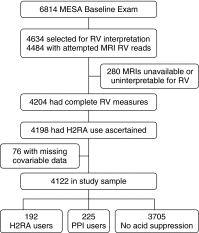H2 receptor antagonists and right ventricular morphology: the MESA right ventricle study
- PMID: 25295642
- PMCID: PMC4298988
- DOI: 10.1513/AnnalsATS.201407-344OC
H2 receptor antagonists and right ventricular morphology: the MESA right ventricle study
Abstract
Rationale: H2 receptor antagonist (H2RA) use is common and may act directly on the heart through myocardial H2 receptors or indirectly through changes in pulmonary vascular resistance.
Objectives: To determine the relationship between histamine H2RA use and right ventricular (RV) morphology.
Methods: We studied 4,122 participants in the Multi-Ethnic Study of Atherosclerosis without clinical cardiovascular disease who had magnetic resonance imaging assessment of RV morphology and ascertainment of medication use. Multivariable linear regression estimated cross-sectional associations between H2RA use and RV morphology after adjusting for demographics, anthropometrics, smoking status, diabetes mellitus, and hypertension. Further adjustments for co-medication use, left ventricular parameters, lung structure and function, renal function, or inflammatory markers were considered in separate models. Analyses in a subcohort restricted to H2RA or proton pump inhibitor users accounted for confounding by the indication of gastroesophageal reflux disease.
Measurements and main results: H2RA use was associated with lower RV mass (-0.7 g; 95% confidence interval, -1.2 to -0.2 g; P = 0.004) and smaller RV end-diastolic volume (-4.2 ml; 95% confidence interval, -7.2 to -1.2 ml; P = 0.006). This relationship was unchanged with adjustment for co-medication use, lung structure and function, renal function, and inflammation. The relationship with RV mass was independent of left ventricular mass. Results were similar in the smaller cohort restricted to proton pump inhibitor and H2RA users.
Conclusions: H2RA use was associated with lower RV mass and smaller RV end-diastolic volume. Additional study of histamine and H2 receptors in cardiopulmonary diseases affecting the RV may have direct clinical relevance.
Keywords: heart ventricles; histamine; histamine H2 receptors; pulmonary hypertension.
Figures


References
-
- Sigterman KE, van Pinxteren B, Bonis PA, Lau J, Numans ME.Short-term treatment with proton pump inhibitors, H2-receptor antagonists and prokinetics for gastro-oesophageal reflux disease–like symptoms and endoscopy negative reflux disease Cochrane Database Syst Rev[serial on the Internet]. 2013[accessed October 2014];5CD002095Available from: http://summaries.cochrane.org/ - PMC - PubMed
-
- Jacobson BC, Ferris TG, Shea TL, Mahlis EM, Lee TH, Wang TC. Who is using chronic acid suppression therapy and why? Am J Gastroenterol. 2003;98:51–58. - PubMed
-
- Laheij RJ, Sturkenboom MC, Hassing R, Dieleman J, Stricker BH, Jansen JB. Risk of community-acquired pneumonia and use of gastric acid–suppressive drugs. JAMA. 2004;292:1955–1960. - PubMed
-
- Lam JR, Schneider JL, Zhao W, Corley DA. Proton pump inhibitor and histamine 2 receptor antagonist use and vitamin B12 deficiency. JAMA. 2013;310:2435–2442. - PubMed
-
- Bristow MR, Ginsburg R, Harrison DC. Histamine and the human heart: the other receptor system. Am J Cardiol. 1982;49:249–251. - PubMed
Publication types
MeSH terms
Substances
Grants and funding
- R01-HL086719/HL/NHLBI NIH HHS/United States
- N01 HC095169/HL/NHLBI NIH HHS/United States
- N01-HC95165/HC/NHLBI NIH HHS/United States
- R01 HL077612/HL/NHLBI NIH HHS/United States
- RC1 HL100543/HL/NHLBI NIH HHS/United States
- N01 HC095159/HL/NHLBI NIH HHS/United States
- N01-HC95159/HC/NHLBI NIH HHS/United States
- KL2TR000421/TR/NCATS NIH HHS/United States
- R01-HL077612/HL/NHLBI NIH HHS/United States
- N01-HC95169/HC/NHLBI NIH HHS/United States
- R01 HL086719/HL/NHLBI NIH HHS/United States
- K24-103844/PHS HHS/United States
- RC1-HL100543/HL/NHLBI NIH HHS/United States
- KL2 TR000421/TR/NCATS NIH HHS/United States
- UL1 TR000423/TR/NCATS NIH HHS/United States
- N01 HC095165/HL/NHLBI NIH HHS/United States
- K24 HL103844/HL/NHLBI NIH HHS/United States
LinkOut - more resources
Full Text Sources
Other Literature Sources
Medical

